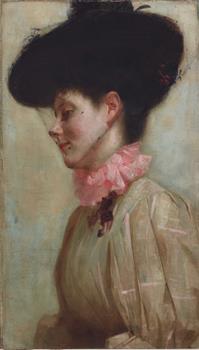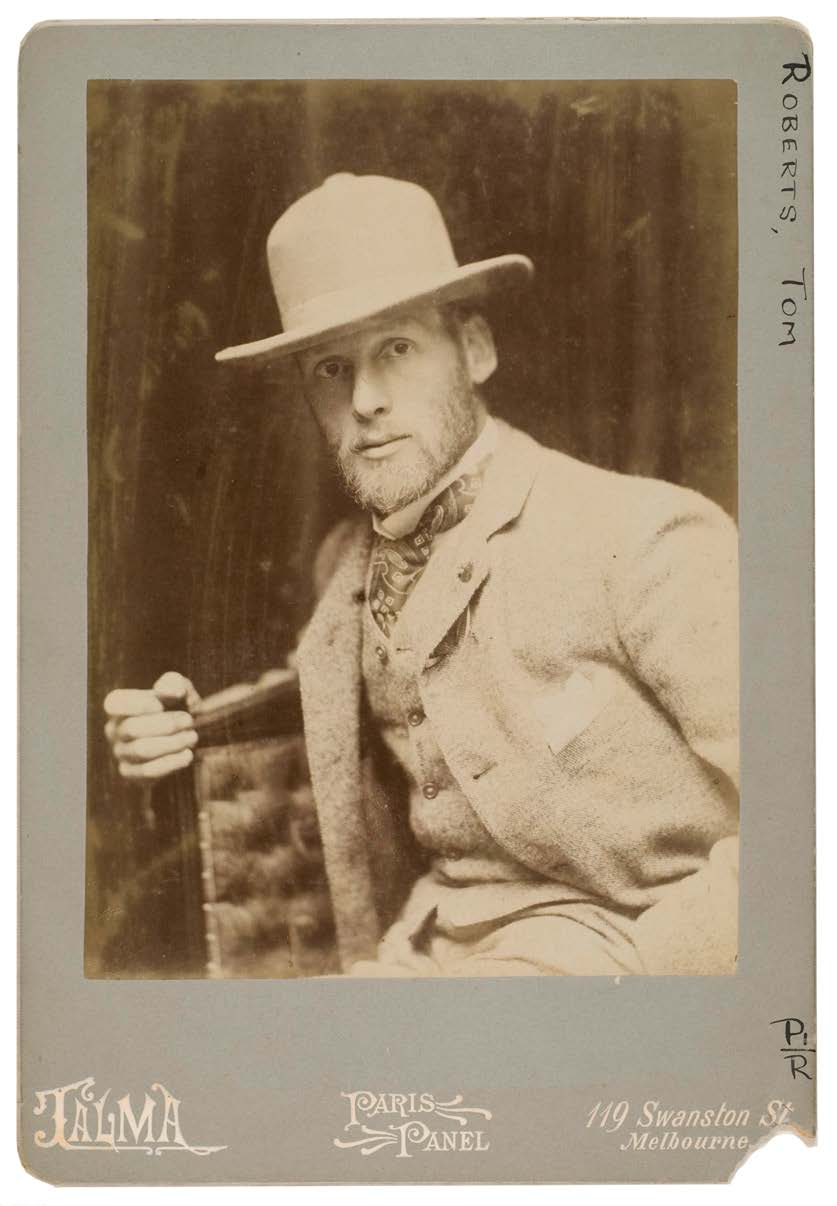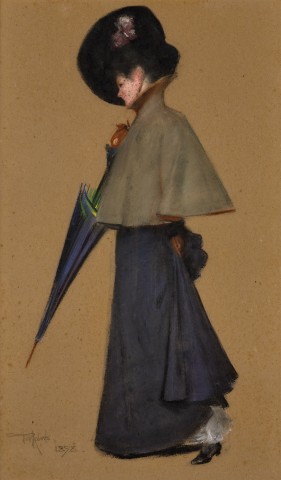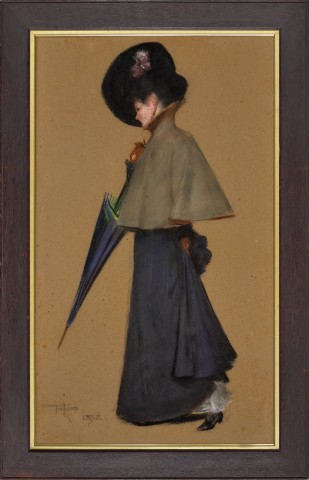PORTRAIT OF FLORENCE GREAVES, 1898
TOM ROBERTS
pastel on paper on compressed card
89.0 x 53.5 cm
signed and dated lower left: Tom Roberts / 1898 .
Private collection
Dalia Stanley & Co., Sydney, 3 December 1995, lot 25
Deutscher Fine Art, Melbourne
Private collection, New South Wales
Tom Roberts: Retrospective, Art Gallery of South Australia, Adelaide, 4 October – 17 November 1996; Tasmanian Museum and Art Gallery, Hobart, 29 November 1996 – 27 January 1997; National Gallery of Victoria, Melbourne, 11 February – 6 April 1997; Art Gallery of New South Wales, Sydney, 18 April – 1 June 1997; Art Gallery of Western Australia, Perth, 11 June – 27 July 1997, cat. 63 (label attached verso)
Radford, R., Tom Roberts: Retrospective, Art Gallery of South Australia, Adelaide, 1996, p. 210 (illus., as ‘Portrait of a standing woman’)
Cotter, J., Tom Roberts & The Art of Portraiture, Thames and Hudson, Melbourne, 2015, fig. 6.5, pp. 278, 280 (illus., as ‘Portrait of a Standing Woman’)
Miss Florence Greaves, 1898, pastel on paper, 41.0 x 34.5 cm, in the collection of the Art Gallery of New South Wales, Sydney
Portrait of Florence, c.1898, oil on canvas on paperboard, 66.6 x 38.7 cm, in the collection of the Art Gallery of New South Wales, Sydney
OA10.1959##S.jpg

Hailed as the father of Australian landscape painting, Tom Roberts holds an important place in the history of Australian art, particularly renowned for great nationalistic pictures painted in the years leading up to Federation, including Shearing the Rams, 1888 – 90 (National Gallery of Victoria) and A Break Away!, 1891 (Art Gallery of South Australia). Signifiers of national identity centred on nineteenth century rural life and activity, these paintings still resonate with contemporary audiences and remain on permanent display in the public galleries that house them.
The fact that portraiture makes up around a third of Roberts’ painted oeuvre comes as something of a surprise, but he was a skilled painter of people, able to capture the mood and character of his subjects in addition to accurately describing their physical likeness. His motivation was often practical – as he once explained to a friend, ‘Portraits pay, … my boy’1 – with commissions of politicians and other public figures easier to secure than patronage for large and time-consuming subject and history pictures.2 Roberts’ was also attuned to the potential historical significance of portraiture however, and in 1896 he embarked on a series of small paintings on timber panels titled ‘Familiar Faces and Figures’ – depicting fellow artists, musicians, journalists and public officials, among others – which he hoped would be kept together for posterity.3
Roberts particularly excelled in the depiction of female subjects and, as Helen Topliss has noted, portraits such as Madame Pfund, c. 1887 (National Gallery of Victoria) and Eileen, 1892 (Art Gallery of New South Wales), reveal his love of female personalities and companionship, as well as his aesthetic response to the decorative elements of women’s dress.4 This full-length pastel of Florence Greaves (1873 – 1959) exemplifies this aspect of his work, making a feature of the flowers on her hat, the delicately-speckled veil and ruffled white petticoats glimpsed beneath the hem of her skirt – highlighting ornamental details in what is otherwise a plain, although very stylish outfit. Depicting his subject in profile, Roberts emphasises her fine features, as well as creating a strong sense of diagonal movement through the composition, leading the eye from her jawbone through to the tip of the umbrella. He adopted a similar view in two other portraits of Greaves made around the same time, a pastel head study dated 1898 and the beautiful bust in oil, Florence Greaves, c.1898, both of which she bequeathed to the Art Gallery of New South Wales.
DH2022 ART Cat (May 2022) FA3.jpg

Greaves was an early student at Julian Ashton’s Sydney Art School, also studying at London’s Slade School in the late 1920s, and it is likely that it was Ashton who introduced her to Roberts.5 In 1894, Roberts visited the Greaves’ family cattle station, Newbold, located on the Clarence River in northern New South Wales. Returning three years later, he began work on A Mountain Muster, 1897 – 1920s (National Gallery of Victoria) there, painting the portraits of Florence the year after, and another of her mother in 1899.6
1. Roberts quoted in Taylor, G., Those Were the Days, Sydney, 1918, p. 100 quoted in Topliss, H., Tom Roberts 1856-1931, A Catalogue Raisonné, vol. 1, Oxford University Press, Melbourne, 1985, p. 20
2. See Topliss, ibid.
3. See Topliss, ibid., pp. 21-22
4. Topliss, H., ‘Portraiture and Nationalism’ in Radford, R., Tom Roberts, Art Gallery of South Australia, Adelaide, 1996, p. 154
5. Kolenberg, H., Ryan, A. and James, P., 19th century Australian Watercolours, Drawings & Pastels from the Gallery’s Collection, Art Gallery of New South Wales, Sydney, 2005, p. 120
6. Mrs W. A. B Greaves, 1899, oil on canvas, 77.5 x 60.0 cm (oval), Art Gallery of New South Wales
KIRSTY GRANT

